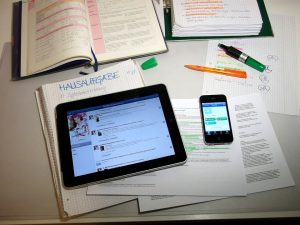Enhancing Focus and Attention in a World of Distractions
March 31, 2019 - 4 minutes readI have shared with many in the community that recently undertook the personal challenge of beginning a doctoral programme. Since beginning the programme in January, I have had the opportunity to have my thinking challenged and develop a deeper understanding of issues in education, social change and technology. 
After so many articles and books with doomsday prophesies and warnings about the technologically-related dangers facing our current youth, a distracted generation, I recently read an article “The distracted student mind – enhancing its focus and attention” (Rosen, 2017) and was particularly appreciative of the “Strategies to deepen focus and attention” outlined in the article and therefore thought I would share them as ways that may help us all to develop better habits with our devices:
- Our brains need the occasional rest:
- Spend no longer than 90 minutes at a time with technology followed by 10-15 minutes of activities that neuroscience has shown to calm the brain
- Activities could include going outside in nature, exercising, listening to music, meditating, taking a hot bath or shower, talking to a friend in person, playing a musical instrument, or practicing a language
- Build stamina for studying or reading with tech breaks. There may be a need to relearn how to focus for uninterrupted periods of time if smartphone use has become habitual.
- Shut down any apps on the smartphone and set a timer on the phone for 15 minutes, during which time set the phone to “Do Not Disturb”, silence it, turn it upside down, and put it within sight.
- Gradually increase the time and reinforce that the task-at-hand be finished before rushing to check the phone.
- Share with friends that online check-ins will occur less frequently, so they know not to keep texting repeatedly if there is no response.
- Treat sleep as sacred.
- The National Sleep Foundation advises that people not engage in any active technology use one hour before bedtime (many technologies produce light in the blue spectrum which block the production of melatonin)
- LED-based technology should be placed no closer than 14 inches from one’s face and the brightness dimmed (many iPhone and Android phones include a setting that can be applied that gradually changes the light from blue to pink at night)
- One hour before bed, calm your brain by reading a paper book (paper reflects light in the warm spectrum which allows the continued the secretion of melatonin), listening to a playlist of favourite songs – ones that you know so well you could “sing them in your sleep” (as that requires less mental effort than listening to new music)
- Learn how to and teach others to minimize the alerts and notifications and consider moving apps into folders so that fewer icons will catch their eye when they unlock their phone – this way, opening apps is a more deliberate action.
- Create tech-free zones such as the bedroom, dinner table, restaurants, the car.
In implementing these strategies, we can hope to educate our children and help them to think and develop good habits so that they make conscious healthy choices on how they interact with their technology.
Reference
Rosen, L. (2017, October). The distracted student mind – enhancing its focus and attention. The Phi Delta Kappan, 99(2), 8-14.